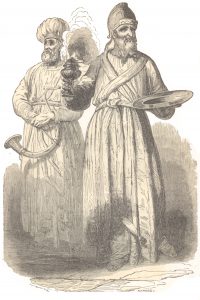 Last week we looked at the Messiah Factors of 7, 13 & 14 and their relationship to the Bible’s sacred festivals and a Biblical reckoning of time. Today in Part II of this fascinating exploration of the Bible Messianic symbolism we will look at the 13th Enumeration, the Root of David, the Hebrew word behind “His Anointed”, and how each of these are important parts of how Yahweh describes His redemptive plan for mankind.
Last week we looked at the Messiah Factors of 7, 13 & 14 and their relationship to the Bible’s sacred festivals and a Biblical reckoning of time. Today in Part II of this fascinating exploration of the Bible Messianic symbolism we will look at the 13th Enumeration, the Root of David, the Hebrew word behind “His Anointed”, and how each of these are important parts of how Yahweh describes His redemptive plan for mankind.
The 13th Enumeration
We’ll start today by looking at one of the most fascinating enigmas of the Bible, namely the lineage of Yeshua as presented by the apostle Matthew in the 1st chapter of the New Testament.
For those who don’t know, it has long been understood that Matthew wrote his account of Yeshua’s life and ministry to his Jewish brethren. In other words, this gospel account uses Biblical (Jewish) idiom, symbolism, and type. So when reading this gospel account it’s important to view it through this contextual lens.
So what do we find as the opening argument in Matthew’s account of Yeshua as the promised Messiah? We have a lineage of Yeshua as a son of Abraham and David. This lineage is used to establish Yeshua bona fides as a legitimate descendant of the two main Biblical heros through which the promised Messiah was prophesied to come.
Take a look at Matthew’s lineage of Yeshua. See if anything stands out to you. Once you’ve had a chance to study this ancient list of names, we’ll explore it in depth and I’ll show you some important details that will really thrill you.
The book of the generation of Jesus Christ, the son of David, the son of Abraham…
So all the generations from Abraham to David are fourteen generations; and from David until the carrying away into Babylon are fourteen generations; and from the carrying away into Babylon unto Christ are fourteen generations. (Matthew 1:1 & 17)
Matthew’s generational listing of Yeshua’s ancestors is unique in the Biblical record on several accounts:
- First of all, it is arranged in three epics or groupings of 14 generations. In consideration of the sacrificial symbolism we have explored in Part I of this article it should come as no surprise that Matthew would emphasis the number 14 in relationship to Yeshua as the promised Messiah.
- Second, while this list is described a grouping of three 14 person generations, in actual fact, Matthew presented only 14 + 14 +13 generations. In other words, there are only 41 names in Yeshua’s lineage instead of the 42 implied by the 3×14 generational grouping. Matthew made Yeshua the 13th generation or what I like to call the 13th Enumeration.
- Third, Matthew purposely left out 4 of Yeshua’s ancestors in order to present his arrangement of Yeshua’s lineage the way he did. These omissions were chosen to emphasis some very important information Matthew was trying to convey in this list.
I want to stress here, that for Matthew to take the liberties he did with Yeshua’s lineage he had to have had a greater purpose in mind. A purpose which instead of detracting from the credibility would further clarify to his Jewish readers the character and nature of Yeshua as the promised Messiah.
To you and I, whom the Law of Moses and its sacrificial symbolism is foreign, Yeshua’s lineage is just a list of names. But the 2nd temple era Jewish reader or one steeped in the Torah today, Yeshua’s lineage is a bold association between Yeshua and the sacrificial redemptive nature of his life. Let’s start our exploration of this list by looking at Yeshua as both the 13th & 14th generation.
13 Given 14 Implied
One of the many unique features of Yeshua’s lineage in Matthew is the difference between what is implied or described and what is given in the list. In Matthew 1:17 the author describes 3 sets of 14 generations. But for those counting, there are in reality 14 + 14 + 13 names given in Yeshua’s lineage. This is actually a pretty ingenious representation of Yeshua and the dual nature of the promise Messiah.
In the Scripture, the coming Messiah is represented as both a suffering servant who took upon himself the sins of mankind as well as a future reigning king. A good example of the former is found in Isaiah 53. Take a moment to appreciate an excerpt of this wonderfully prophetic passage:
Who hath believed our report? and to whom is the arm of YHWH revealed…
He is despised and rejected of men; a man of sorrows, and acquainted with grief: and we hid as it were our faces from him; he was despised, and we esteemed him not…
Surely he hath borne our griefs, and carried our sorrows: yet we did esteem him stricken, smitten of God, and afflicted. But he was wounded for our transgressions, he was bruised for our iniquities: the chastisement of our peace was upon him; and with his stripes we are healed…
All we like sheep have gone astray; we have turned every one to his own way; and YHWH hath laid on him the iniquity of us all. He was oppressed, and he was afflicted, yet he opened not his mouth: he is brought as a lamb to the slaughter, and as a sheep before her shearers is dumb, so he openeth not his mouth…
for he was cut off out of the land of the living: for the transgression of my people was he stricken…
And he made his grave with the wicked, and with the rich in his death; because he had done no violence, neither was any deceit in his mouth.
Yet it pleased YHWH to bruise him; he hath put him to grief: when thou shalt make his soul an offering for sin, he shall see his seed, he shall prolong his days, and the pleasure of YHWH shall prosper in his hand.
He shall see of the travail of his soul, and shall be satisfied: by his knowledge shall my righteous servant justify many; for he shall bear their iniquities.
Therefore will I divide him a portion with the great, and he shall divide the spoil with the strong; because he hath poured out his soul unto death: and he was numbered with the transgressors; and he bare the sin of many, and made intercession for the transgressors. (Isaiah 53:1-12 excerpted)
No mistaking the sacrificial redemptive aspect of the Messiah in that passage. Now contrast that with the following passage from Isaiah 11 where this offspring from Jesse (father of King David) is described as reigning during the millennial age.
And there shall come forth a rod out of the stem of Jesse, and a Branch shall grow out of his roots:..
But with righteousness shall he judge the poor, and reprove with equity for the meek of the earth: and he shall smite the earth with the rod of his mouth, and with the breath of his lips shall he slay the wicked….
The wolf also shall dwell with the lamb, and the leopard shall lie down with the kid; and the calf and the young lion and the fatling together; and a little child shall lead them. And the cow and the bear shall feed; their young ones shall lie down together: and the lion shall eat straw like the ox. And the sucking child shall play on the hole of the asp, and the weaned child shall put his hand on the cockatrice’ den.
They shall not hurt nor destroy in all my holy mountain: for the earth shall be full of the knowledge of YHWH, as the waters cover the sea. And in that day there shall be a root of Jesse, which shall stand for an ensign of the people; to it shall the Gentiles seek: and his rest shall be glorious. (Isaiah 11:1-10 excerpted)
As you can see Isaiah describes this Messianic redeemer in terms of both a suffering servant and reigning king. In his letter to the Romans, the apostle Paul emphasises Yeshua as seed of David and the Son of God.
Concerning his Son Jesus Christ our Lord, which was made of the seed of David according to the flesh; And declared to be the Son of God with power, according to the spirit of holiness, by the resurrection from the dead: (Romans 1:3-4)
Now let’s look at Matthew’s list once more. Even though Yeshua is given as the 13th generation, Matthew clearly implied that He is also the 14th generation. This symbolically represents the Messiah both as the literal seed of David (13) and the implied (prophetic) Son of God (14). In other words, Yeshua came into this world as a man (6) and god (7), in reality a God/man who Matthew represents by the 13 generation. After His death, he became upon His resurrection, he became the first fruits, the son of God / risen savior (7+7), the implied 14th generation.
For unto us a child is born, unto us a son is given [Yeshua, the 13th generation]: and the government shall be upon his shoulder: and his name shall be called Wonderful, Counsellor, The mighty God, The everlasting Father, The Prince of Peace.
Of the increase of his government and peace there shall be no end, upon the throne of David [Yeshua the Messiah, the 14th generation, the reigning king], and upon his kingdom, to order it, and to establish it with judgment and with justice from henceforth even for ever. The zeal of YHWH of hosts will perform this. (Isaiah 9:6–7)
The Root & Throne of David
One of the most important aspects of Yeshua’s authenticity as the Messiah was his lineage from king David as prophesied in multiple locations in the Bible. Notice in Matthew’s lineage that king David is the 14th generation from Abraham. Accenting this arrangement David is also mentioned twice.
So all the generations from Abraham to David are fourteen generations; and from David until the carrying away into Babylon are fourteen generations; and from the carrying away into Babylon unto Christ are fourteen generations. (Matthew 1:17)
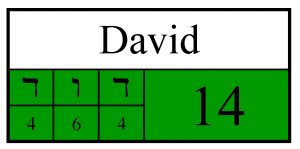 Matthew’s arrangement of Yeshua’s lineage accentuates this position by describing Yeshua as 3 x 14 generations from Abraham and 2 x 14 generations from David. This symbolism is further driven home by the fact that not only is David the 14th generation from Abraham, but the Hebrew value of his name is 14 as well.
Matthew’s arrangement of Yeshua’s lineage accentuates this position by describing Yeshua as 3 x 14 generations from Abraham and 2 x 14 generations from David. This symbolism is further driven home by the fact that not only is David the 14th generation from Abraham, but the Hebrew value of his name is 14 as well.
Yeshua’s relationship to King David is so important that the New Testament authors repeatedly referred to it. Yeshua Himself also mentioned this in several locations, significantly emphasizing this in His final message to the churches as described in the book of Revelation.
I Jesus (Yeshua) have sent mine angel to testify unto you these things in the churches. I am the root and the offspring of David, and the bright and morning star. (Revelation 22:16)
And one of the elders saith unto me, Weep not: behold, the Lion of the tribe of Juda, the Root of David, hath prevailed to open the book, and to loose the seven seals thereof. And I beheld, and, lo, in the midst of the throne and of the four beasts, and in the midst of the elders, stood a Lamb as it had been slain, having seven horns and seven eyes, which are the seven Spirits of God sent forth into all the earth. (Revelation 5:5-6)
In Acts 13 when describing Yeshua to his Jewish brethren, Paul describes Him as the son of God and the offspring of David. Paul also emphasis that Yeshua, as the prophesied son of David, was also the redeemer who brought forgiveness of sins and justification which was not possible by the law of Moses.
God hath fulfilled the same unto us their children, in that he hath raised up Jesus again; as it is also written in the second psalm,
Thou art my Son, this day have I begotten thee. And as concerning that he raised him up from the dead, now no more to return to corruption, he said on this wise, I will give you the sure mercies of David. Wherefore he saith also in another psalm, Thou shalt not suffer thine Holy One to see corruption. For David, after he had served his own generation by the will of God, fell on sleep, and was laid unto his fathers, and saw corruption: But he, whom God raised again, saw no corruption.
Be it known unto you therefore, men and brethren, that through this man is preached unto you the forgiveness of sins: And by him all that believe are justified from all things, from which ye could not be justified by the law of Moses. (Acts 13:33-39)
The kings of the earth set themselves, and the rulers take counsel together, against YHWH, and against his anointed, saying, Let us break their bands asunder, and cast away their cords from us. He that sitteth in the heavens shall laugh: the Lord shall have them in derision. Then shall he speak unto them in his wrath, and vex them in his sore displeasure.
Yet have I set my king upon my holy hill of Zion. I will declare the decree: YHWH hath said unto me, Thou art my Son; this day have I begotten thee. (Psalm 2:2-7)
His Anointed
A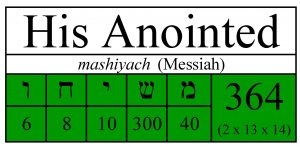 nother aspect of this symbolism worth noting in Paul’s reference to Psalm 2 as discussed above, is that in the Psalm this messianic “Son” of God is also called “his anointed”. In Psalm 2 the Hebrew form of the word (His Anointed) is used and it bears the stamp of the Messiah Factors. (2x13x14)
nother aspect of this symbolism worth noting in Paul’s reference to Psalm 2 as discussed above, is that in the Psalm this messianic “Son” of God is also called “his anointed”. In Psalm 2 the Hebrew form of the word (His Anointed) is used and it bears the stamp of the Messiah Factors. (2x13x14)
Here are few more examples of the importance both the Old and New Testaments place on the Messiah as the offspring of David. As you read them keep Matthew’s lineage in mind. That list of names was written to symbolically emphasize Yeshua’s 14 generation relationship to King David and Abraham.
For unto us a child is born, unto us a son is given: and the government shall be upon his shoulder: and his name shall be called Wonderful, Counsellor, The mighty God, The everlasting Father, The Prince of Peace. Of the increase of his government and peace there shall be no end, upon the throne of David, and upon his kingdom, to order it, and to establish it with judgment and with justice from henceforth even for ever. The zeal of YHWH of hosts will perform this. (Isaiah 9:6-7)
And, behold, thou shalt conceive in thy womb, and bring forth a son, and shalt call his name JESUS. He shall be great, and shall be called the Son of the Highest: and the Lord God shall give unto him the throne of his father David: (Luke 1:31-32)
For thy servant David’s sake turn not away the face of thine anointed. YHWH hath sworn in truth unto David; he will not turn from it; Of the fruit of thy body will I set upon thy throne. If thy children will keep my covenant and my testimony that I shall teach them, their children shall also sit upon thy throne for evermore. For YHWH hath chosen Zion; he hath desired it for his habitation. (Psalm 132:10-13)
The Missing Generations
Now, let’s turn our attention to the missing generations in Yeshua’s lineage, those ancient ancestors of Yeshua that Matthew left out. All sorts of theories have been offered over the centuries as to why Matthew left certain names out of Yeshua lineage. More often than not authors and scholars point to the evil nature of those kings as justification for their ommission. The biggest problem with this theory is that there were kings left in the list who where every bit as evil or even worse as those omitted from the list.
As we saw with Yeshua’s arrangement of the list into three 14 generation groupings and Matthew’s presentation of Yeshua as both the 13th and 14th generation, he was willing to arrange Yeshua’s lineage to illustrate a more important Biblical truth about Yeshua.
The location of the omitted names bear this same mark of intentional symbolism. This is evidenced by the location where these names were left out. Take a look at Matthew’s lineage of Yeshua once more. This time I’ve provided you with a visual representation of where Matthew left out the names. Interestingly, all the names were left out in the 2nd group of 14 generations.
Notice that Matthew didn’t leave any of his symbolism to chance. He omitted 3 names between the 6th & 7th generation and 1 name between the 13th and 14th generation. These omissions are a fantastic example of the saying that sometimes is not what is said that is important, but what is not said.
Take for example the missing king named Jehoiakim between the 13th and 14th generation. We’ve already established that 13 and 14 symbolically represent Yeshua as the seed of David and the Son of God. Well, right there between the 13th and 14th generation Matthew left out Jehoiakim whose name means “YHWH rises up”. Now how awesome is that! Yeshua, the 13th generation, was the living sacrifice for mankind’s sins. He was the one whom “YHWH rises up” to become the 14th generation and mankind’s ruling king upon the throne of David.
Do you still think this accidental? Not a chance! As we will see in Part III of this series this omission between the 13th and 14th generation has additional significance as it relates to Daniel 9 and the prophecy of 70 Sevens.
Matthew 1 and the Bible’s Calendar
Remember where I described the Bible’s calendar and its cycles, notice in Matthew’s list that the omitted names remind the reader of the two most important cycles of the Biblical calendar. Namely, the 6/7 day solar cycle of labor and rest; and the 13/14 day lunar cycle upon which the Biblical holydays are organized and celebrated. This seems deliberate on the part of Matthew as it directs the Jewish reader’s attention towards Yeshua (who YHWH rises up) and His relationship to a Biblical reckoning of time and His fulfillment of the Bible’s holydays which so beautifully symbolize the redemptive nature of Yeshua’s efforts on our behalf.
Did you also notice in Matthew ingenious arrangement of the second 14 generations that the missing names reminds the astute reader of the unusual order of sacrifices (13 to 7) made during the Feast of Tabernacles?
Seeing God – Face to Face
In my research for this article I ran across another example of this symbolism I thought you might appreciate. Remember in Genesis 32 where Jacob wrestles with the angel of God and survives? Well, this encounter has its own symbolism which is marked by the Messiah Factors.
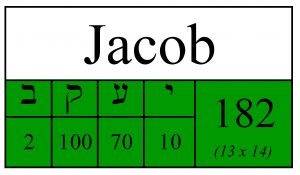 And he said unto him, What is thy name? And he said, Jacob. And he said, Thy name shall be called no more Jacob, but Israel: for as a prince hast thou power with God and with men, and hast prevailed. And Jacob asked him, and said, Tell me, I pray thee, thy name. And he said, Wherefore is it that thou dost ask after my name? And he blessed him there.
And he said unto him, What is thy name? And he said, Jacob. And he said, Thy name shall be called no more Jacob, but Israel: for as a prince hast thou power with God and with men, and hast prevailed. And Jacob asked him, and said, Tell me, I pray thee, thy name. And he said, Wherefore is it that thou dost ask after my name? And he blessed him there.
And Jacob called the name of the place Peniel: for I have seen God face to face, and my life is preserved. (Genesis 32:27-30)
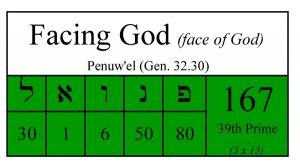 It’s interesting that Jacob (supplanter), the father of the 12 tribes of Israel, before seeing God “face to face” has a name value which includes the Messiah Factors. After seeing God face to face (Peniel) his name is changed to Israel. The word Peniel has the numerical value of 167 which is the 39th (3×13) prime number. The name Israel (God Prevails) has the numerical value of 541 which is the 100th prime number. Interesting no?
It’s interesting that Jacob (supplanter), the father of the 12 tribes of Israel, before seeing God “face to face” has a name value which includes the Messiah Factors. After seeing God face to face (Peniel) his name is changed to Israel. The word Peniel has the numerical value of 167 which is the 39th (3×13) prime number. The name Israel (God Prevails) has the numerical value of 541 which is the 100th prime number. Interesting no?
Shema, Yisrael!
There are few verses in the Old Testament Scriptures that have a more central role in defining the nature of YHWH, the living God of the Bible, than Deuteronomy 6:4. In Jewish tradition, this passage of Torah is recited every morning and evening as part of the “Shema, Yisrael” prayer:
Hear, O Israel: YHWH our God is one YHWH. (Deuteronomy 6:4)
More literally, the verse above would read:
Hear, O Israel, YHWH our God, YHWH is One.
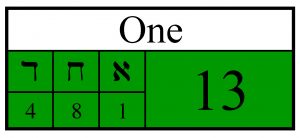 The Hebrew word for “one” is echad. Represented mathematically, echad has a numerical value of 13. YHWH has a numerical value of 26. “YHWH is one” has a value of 39 (3 x 13). Another way to look at it would be to say 39 is 1.
The Hebrew word for “one” is echad. Represented mathematically, echad has a numerical value of 13. YHWH has a numerical value of 26. “YHWH is one” has a value of 39 (3 x 13). Another way to look at it would be to say 39 is 1.
For there are three that bear record in heaven, the Father, the Word, and the Holy Spirit: and these three are one. (1 John 5:7, emphasis mine)
And the Word was made flesh, and dwelt among us, (and we beheld his glory, the glory as of the only begotten of the Father,) full of grace and truth. (John 1:14)
Are you ready for another example? Look at the name Yeshua:
3 is 1 — 39 is 1
The numerical value of Yeshua’s name is fascinating to me. The number 391 is a factor of the 7th and 9th prime numbers (17 x 23). As you can see above, the numbers 3, 9, and 1 are represented, and their combined value is equal to 13 (3 + 9 + 1). (Thanks to my wife, Winnie, for pointing that out to me.) Also represented are the numbers 39 (3 x 13) and 91 (7 x 13). Coincidence or design? I’ll let you decide.
Wherefore God also hath highly exalted him, and given him a name which is above every name: that at the name of Jesus [Yeshua] every knee should bow, of things in heaven, and things in earth, and things under the earth; and that every tongue should confess that Jesus [Yeshua] Christ is Lord, to the glory of God the Father. (Philippians 2:9–11)
Mathematical Mysteries
I admit it: I believe that the world around us reflects the genius of our Creator, YHWH. To my way of looking at it, numbers and mathematics are just one more reflection of that genius. Even today, in our technologically advanced age, we cannot fully explain the order and design of such mathematical ideas as prime numbers, the Fibonacci sequence, or pi. I know that as a high-school educated plumber, I am probably the least qualified to try to explain such wonders, but I can’t help but believe that those mathematical concepts, if they are ever to be explained or understood, will find explanations that are somehow connected to our Creator’s plan of reconciliation for all mankind. Like a coded message or a divine marker, they will someday speak to us of our Creator’s love, much in the same way the Hebrew word for “love” or “to love,” ahabah, has hidden in its letters the value of 13.
Maybe coincidence or design I’ll let you decide but here are some more examples of the Messiah factors.
Prime Numbers
Prime numbers still baffle mathematicians. By definition, they are natural numbers greater than 1 that have no positive divisors other than 1 and the prime number itself. (I’m not sure I understand why, but 1 is not considered a prime number by mathematicians.) Do you remember when we talked about the lineage of Yeshua in Matthew 1 and how Matthew arranged that lineage to show 41 names, making Yeshua the 13th Enumeration? Did you know 41 is the 13th number in the prime sequence? Thirteen, it turns out, is the 6th prime number. Adding further intrigue, the sequential sum of all prime numbers up to and including 13 is 41.
Out of curiosity, we might add 1 back into the prime number list. If we do, 41 becomes the 14th prime and 13 the 7th. The sequential sum then makes 42 (6 x 7). Food for thought, isn’t it?
The first 13 numbers of the prime sequence are as follows:
(1), 2, 3, 5, 7, 11, 13, 17, 19, 23, 29, 31, 37, 41
Prime sequential sum: 2 + 3 + 5 + 7 + 11 + 13 = 41 (41 = 13th prime)
Prime sequential sum + 1: (1) + 2 + 3 + 5 + 7 + 11 + 13 = 42 (6 x 7)
Sequential sum: 1 + 2 + 3 + 4 + 5 + 6 + 7 + 8 + 9 + 10 + 11 + 12 + 13 = 91 (7 x 13)
If you have trouble reading these charts you will find high resolution images at the following link: The 13th Enumeration Images
π
The mathematical definition of pi is “the ratio of a circle’s circumference to its diameter.” In other words, pi is a mathematical way to show the relationship between a circle and any straight line dividing that circle. Symbolically, we could look at pi as showing the relationship between a circle (the eternal) and a straight line (linear time). Did you know that scientists, after thousands of years, still don’t completely understand pi? Though 3.141592 is an approximate representation, pi is an irrational number, which means its decimal representation never ends. Using supercomputers, mathematicians have now computed pi up to the 12 trillionth decimal digits. In all those decimal representations, pi still does not fall into a permanent repeating pattern. Dare I say that pi in some ways reminds us of YHWH’s unfathomed majesty?
As I’ve said before, I think all creation reflects YHWH’s genius and His love for His creation. Even pi, to my way of thinking, must somehow show that genius in a way we can understand and appreciate. With this thought in mind, let me give a rather timid attempt to show the fingerprint of our Creator in this unsolved mathematical mystery.
We’ve already seen the connection between 7 and 13 in the biblical record concerning the Messiah. Even prime numbers and the Fibonacci sequence show such a subtle relationship. Now, take a look at the first 41 digits of pi—keeping in mind that 41 is the 13th prime and the number of names in Matthew’s lineage of Yeshua.
3.1415926535897932384626433832795028841971
Some might call it a coincidence, and I get that, but notice the first 7 digits. Seven in biblical symbolism reflects divine perfection. Are any of the above numbers familiar to you? Not really?
How about now?
295 14 13
Yes, the first seven numbers of pi, when reversed, give us the very cycles that have defined the Bible’s religious (lunar) calendar for thousands of years. Coincidence? Or intentional?
Personally, I think YHWH has a sense of humor. I think pi was designed in such a way as to confound the skeptics and give the rest of us a hint of His redemptive genius. Do you remember the place these numbers are first mentioned together in the Bible? Ironically, it is in the book of Numbers chapter 29 verse 13, and it describes 29 unique sacrifices on the first day of the Feast of Tabernacles—sacrifices divided into 13 bullocks, 2 rams, and 14 lambs.
The first 7 days of the feast, I might remind you, are the only place in the biblical record where the sacrifices are given in a descending order—reversing the norm.
And ye shall offer a burnt offering, a sacrifice made by fire, of a sweet savour unto YHWH; thirteen young bullocks, two rams, and fourteen lambs of the first year; they shall be without blemish. (Numbers 29:13)
Just to challenge our skepticism a little more, take a look at the 41 digits of Pi above. The first 7 found in pi is in the 13th decimal digit. The next 7 is found in the 29th place between 2 and 9. The third 7 in pi is found in the 39th decimal digit—3 x 13. Really? Kind of hard to call that a coincidence , isn’t it?
For ye see your calling, brethren, how that not many wise men after the flesh, not many mighty, not many noble, are called:
But God hath chosen the foolish things of the world to confound the wise; and God hath chosen the weak things of the world to confound the things which are mighty; (1 Corinthians 1:26-27 26)
The Number of Yeshua in Pi
While we are on the subject of pi, I can’t be the only person to wonder where 391 (the numerical value of Yeshua’s name) is first found in the digits of pi. The numerical value of Yeshua’s name first shows up in the 1381st digit of pi. That number, as it turns out, is the 221st prime number, with factors of 13 x 17. The digits of 1381 are equal to 13, and for those mathematicians out there, the first 7 digits of 1381’s decimal logarithm are 3.140193. And yes, that’s pi and the number of Yeshua’s name reversed.
Finally, 391 is first found in the 1381st digit of pi between 26 (the numerical value of “YHWH”) and 41 (the 13th prime). YHWH—Yeshua—13th prime. What do you think are the odds?
. . . 7496473 26 391 41 9927260. . .
Sin and the Law
If you will recall, I suggested if the answers to the world’s mathematical mysteries are found, I believe they will be connected to the story of our reconciliation with YHWH. My eccentric musings aside, the Bible is clear that mankind is in need of redemption and reconciliation to the Creator. Without the reconciliation made possible by the blood of Yeshua, mankind is guaranteed death and eternal separation from YHWH, our Creator.
The law, as given in the Old Testament, illustrates just how far we’ve fallen short of YHWH’s righteous standard:
But the scripture hath concluded all under sin, that the promise by faith of Jesus Christ might be given to them that believe. But before faith came, we were kept under the law, shut up unto the faith which should afterward be revealed. Wherefore the law was our schoolmaster to bring us unto Christ, that we might be justified by faith. (Galatians 3:22–24)
Mankind and our struggle under the curse of sin is represented symbolically by the number 6. Sin in the Bible is defined as a transgression of the law. Atonement for that sin required sacrificial substitution or atonement. As we have seen in the Old Testament, that sacrificial atonement is often associated with the number 13.
The New Testament writers explain that Yeshua, the 13th Enumeration of Matthew 1, made permanent atonement for mankind’s sins. Appropriate, then, that Jewish scholars have counted every law in the Torah and found there are 613 mitzvot, or commandments!
I started this series by looking at Yeshua’s statement about fulfilling the law (here). Do you think that maybe their was more to Yeshua statement that He came not to destroy the law but fulfill!
Think not that I am come to destroy the law, or the prophets: I am not come to destroy, but to fulfil. For verily I say unto you, Till heaven and earth pass, one jot or one tittle shall in no wise pass from the law, till all be fulfilled. (Matthew 5:17–18)
6-13 indeed!
Yeshua and the Bible’s Sacrificial Symbolism
I hope this article has impressed upon you the unique messianic symbolism the numbers 7, 13, and 14 have in Yahweh’s redemptive plan for mankind. It is apparent that these numbers are intimately connected to the Bible’s sacred holydays and the sacrificial system as given by YHWH to Moses in what we know today as the Torah. It is clear from the writings of the apostles that they were aware of much, if not all, of this symbolism and they often pointed to this symbolism as exemplified by the Bible’s holydays and its sacrificial service as pictures or shadows of the redemptive nature of Yeshua efforts on mankind’s behalf.
In the Part III of this series on Bible Prophecy and the Law of Moses we will discover how all this symbolism found in the Torah provides us with the necessary background to interpreting the only messianic prophecy in the Bible which gives a specific datable time by which a single person in the history of the world can be identified as the Bible’s promised Messiah.
I hope you’ll continue this adventure with me next time as we explore Seven, 70, & Sevens: Daniel 9 and the Bible’s Messianic Symbolism
Whom Yahweh’s Raises
In closing I offer you one last bit of messianic symbolism, that perfectly illustrates YHWH’s redemptive plan for mankind through Yeshua. Take a look at the name meanings in the 13th and 14th generations in Yeshua’s lineage. Add back in the missing (hidden) king Jehoiakim and read the name story that results:
The redemptive story goes something like this:
The gift / I possess, beloved whom Yahweh heals, Yahweh raises up, and established Yeshua, Yahweh’s Salvation.
Maranatha!
Bible Prophecy and the Law of Moses
Part I – The Bible’s Holy Days: Pictures of the Messiah
Part II (a) – The Messiah Factors: Numerical Evidence of Yahweh’s Redemptive Plan
Part II (b) – The Messiah Factors: Numerical Evidence of Yahweh’s Redemptive Plan
Part III – Seven, 70, & Sevens: Daniel 9 & the Bible’s Messianic Symbolism

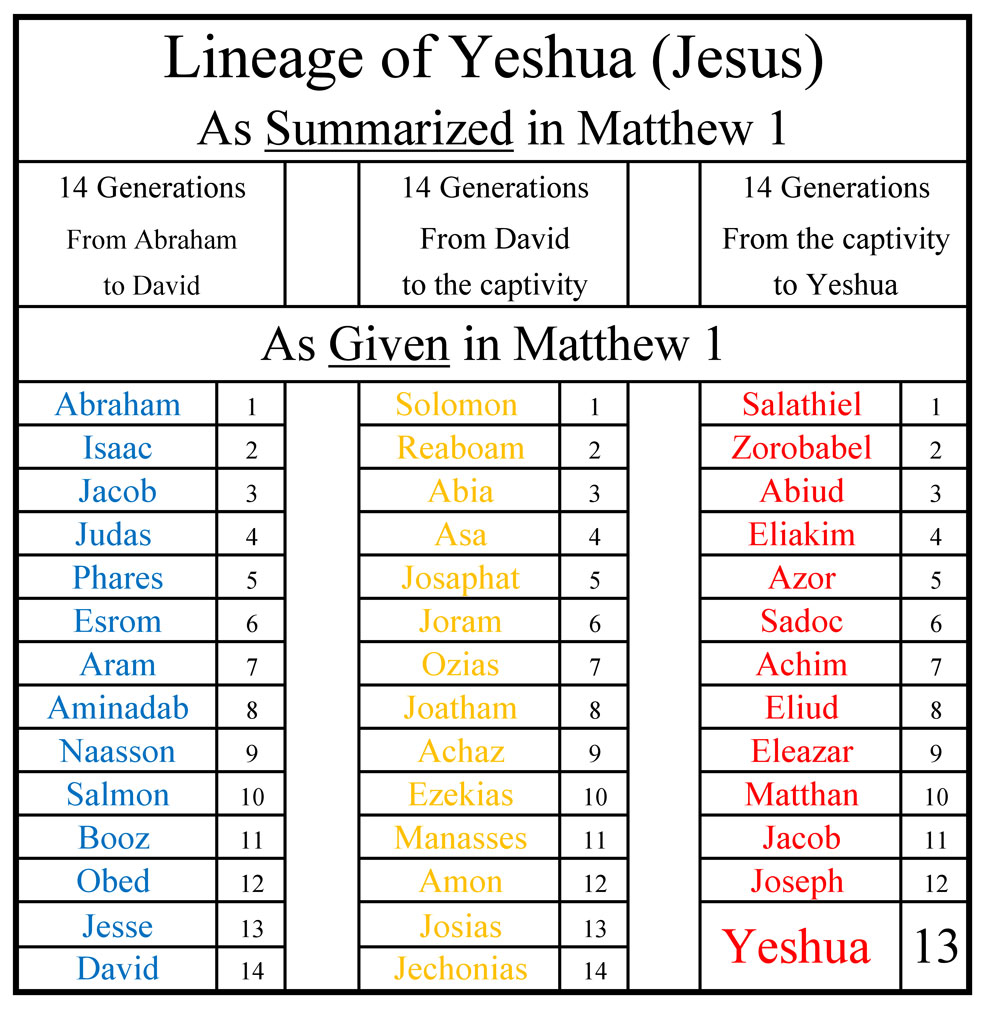
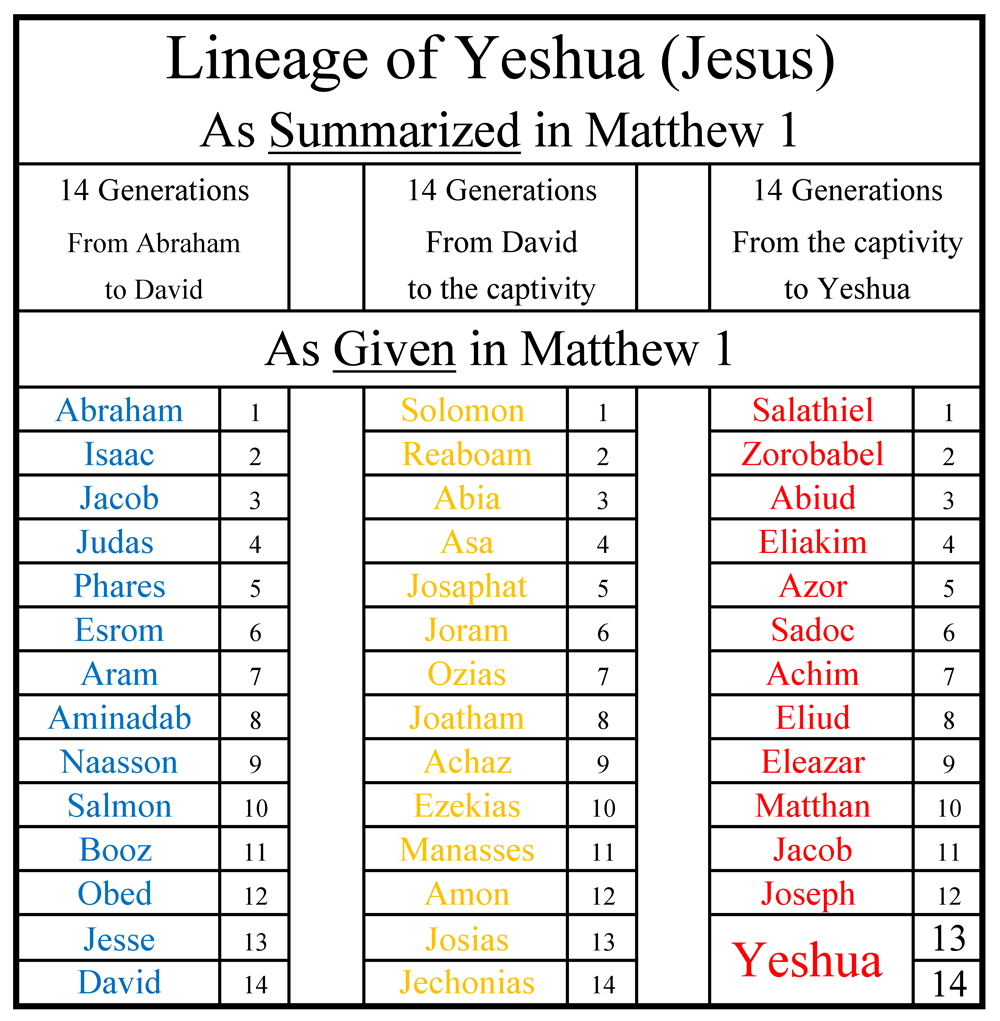
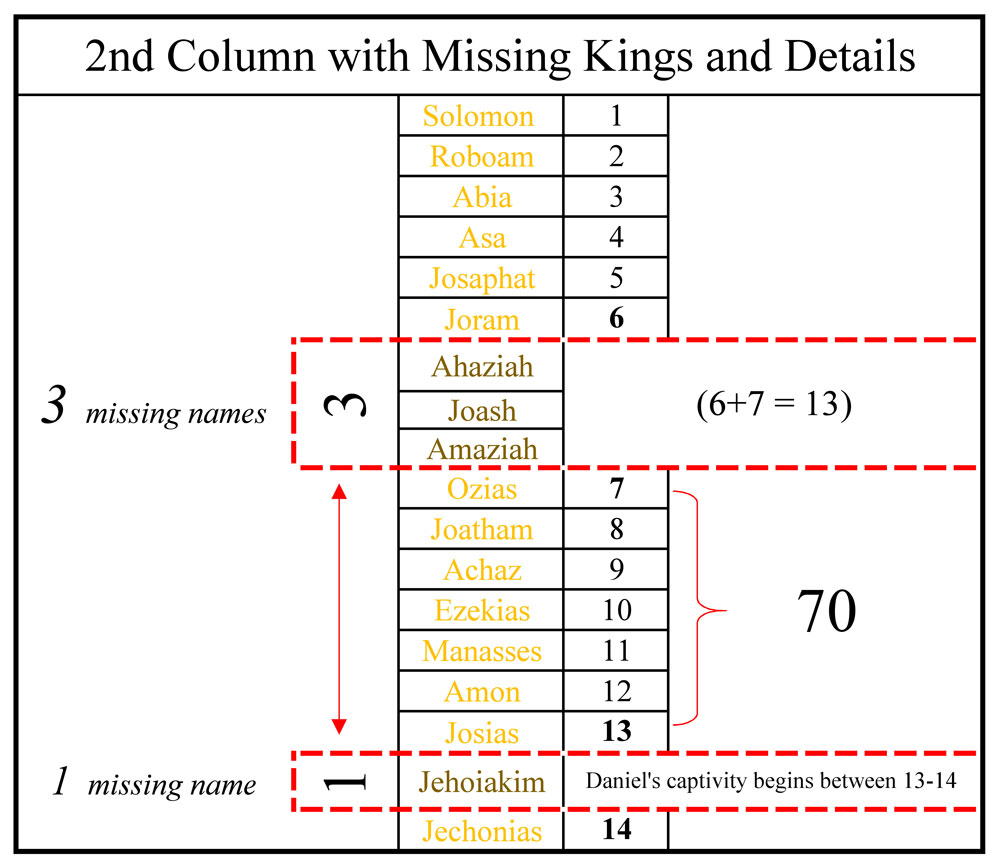
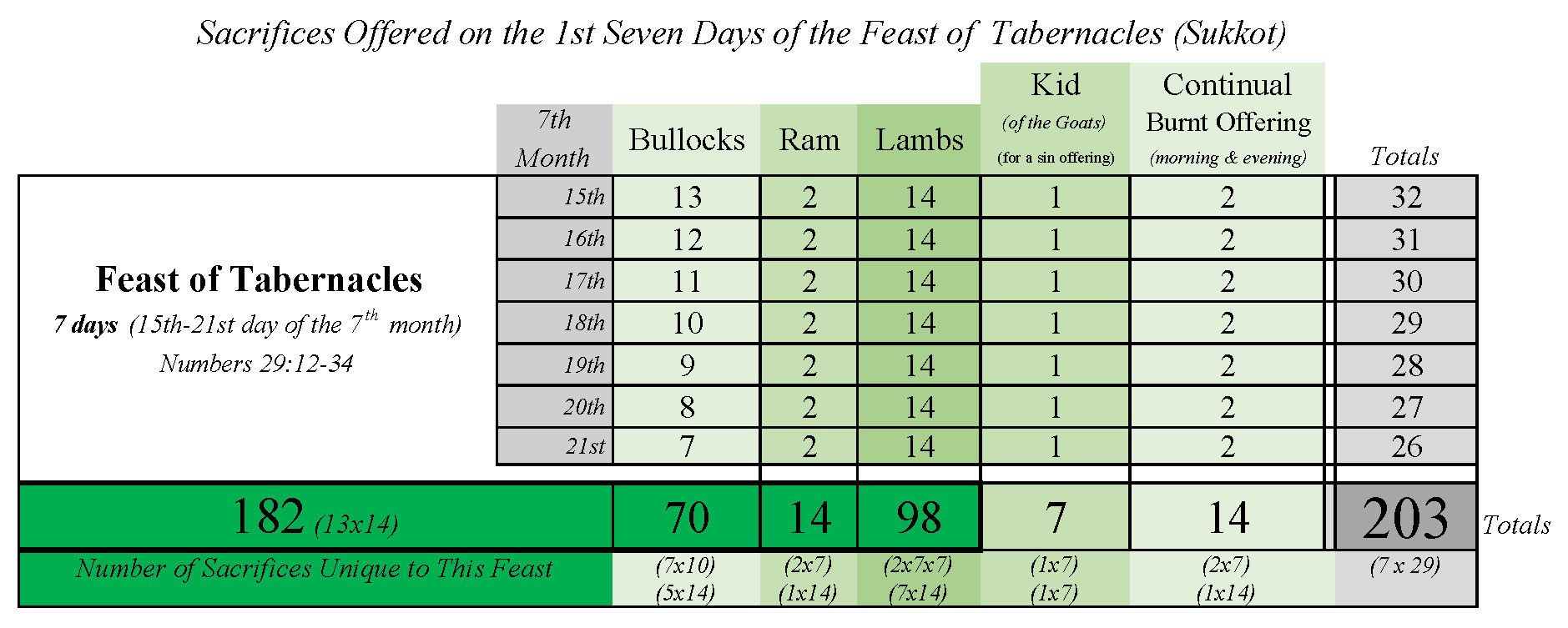
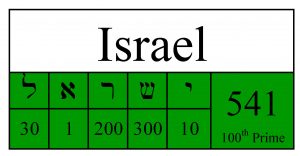
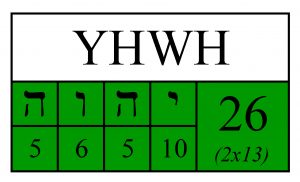
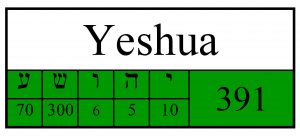
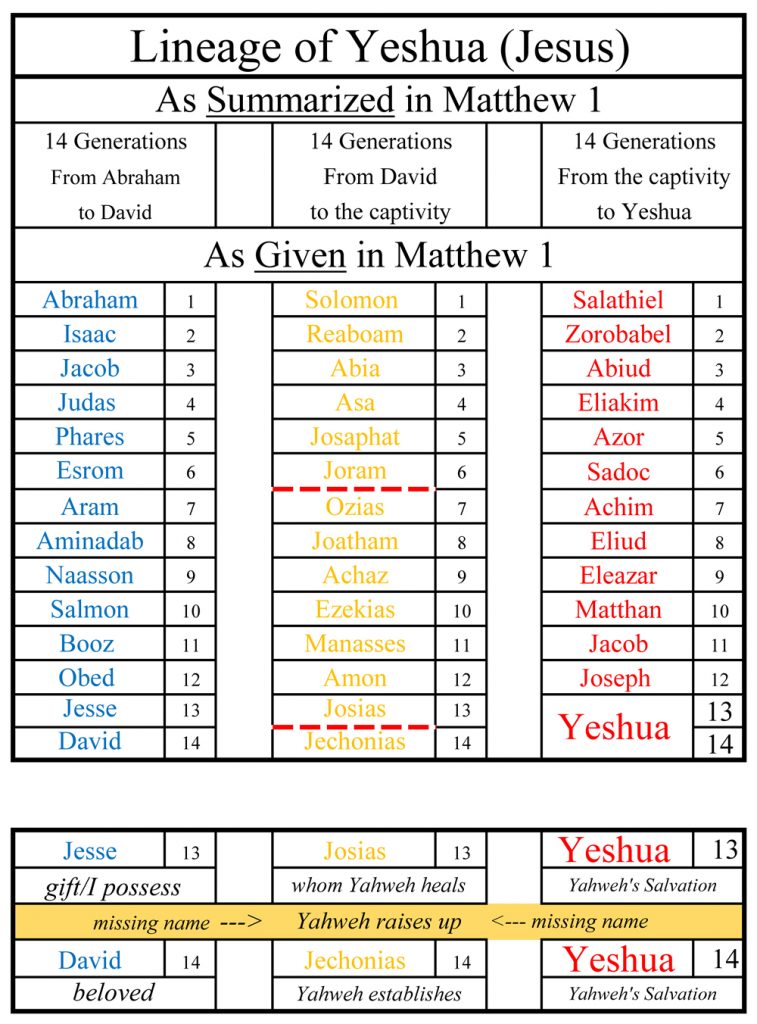



Hi Bill. Great series so far! Here is a link to a very interesting video on “the curse of Jeconiah”. https://www.youtube.com/watch?v=p4v1UEZb3Z0
Hi Greg,
Thanks for the link. That is an interesting video. Another solution to the curse of coniah is that this lineage was not the physical line of Yeshua. I wrote a bit about the subject here: http://www.the13thenumeration.com/Blog13/2017/12/07/the-curse-of-coniah-the-promised-messiah/
Warm regards,
William